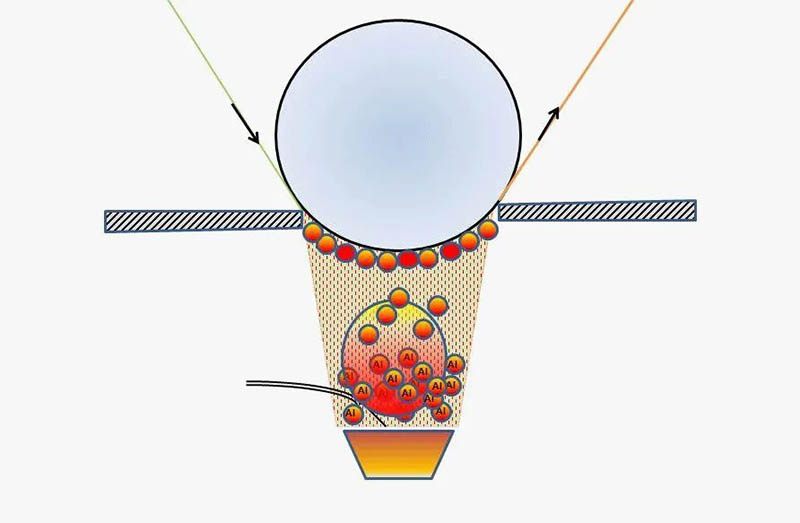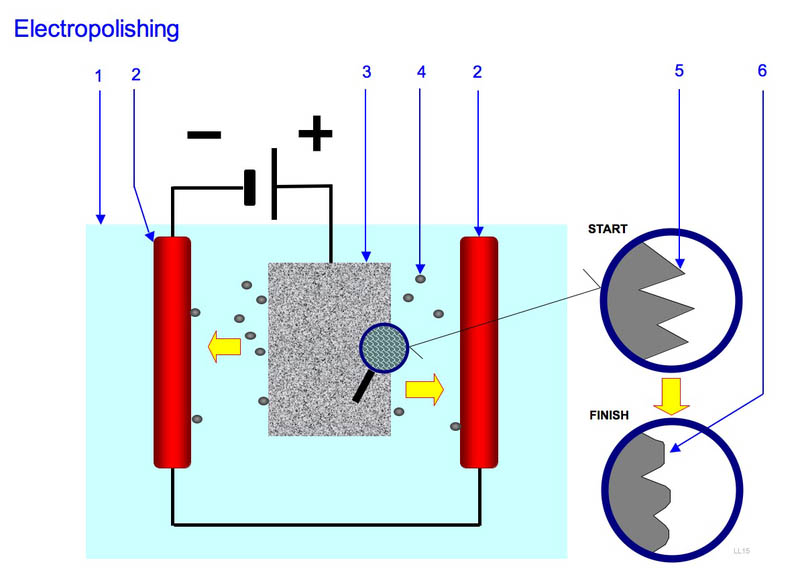Comprehensive Guide to Surface Treatment Techniques for Vape and E-cigarette Materials
Surface treatment involves the artificial formation of a layer on the surface of the base material, which possesses different mechanical, physical, and chemical properties from the base itself.
The primary purpose of surface treatment is to meet product requirements such as corrosion resistance, wear resistance, decorative appeal, or other specialized functionalities. Commonly used surface treatment methods for e-cigarette materials include mechanical polishing, chemical treatments, surface heat treatments, and surface coating. These processes involve cleaning, scanning, deburring, degreasing, and removing oxidation layers from the surface of the workpiece. Let's explore the various surface treatment techniques applicable to e-cigarette materials.
Common Surface Treatment Techniques:
Vacuum Metalizing - Also known as Vacuum Plating, is a physical deposition process that takes place in a vacuum state where argon gas is injected to collide with the target material. This collision causes the target material to separate into molecules, which are then adsorbed onto the conductive substrate, forming a uniform and smooth metallic-like surface layer.
Applicable Materials:
Vacuum metalizing is suitable for a wide range of materials, including metals, soft and hard plastics, composite materials, ceramics, and glass. The most commonly used materials for vacuum metalizing in e-cigarette materials are aluminum, followed by silver and copper.
Natural materials are not suitable for vacuum metalizing due to the potential impact of their moisture content on the vacuum environment.
Process Cost:The vacuum metalizing process involves tasks such as spraying, loading, unloading, and respraying the components, making the labor costs relatively high. However, the cost also depends on the complexity and quantity of the workpieces.
Environmental Impact:Vacuum metalizing has a minimal impact on the environment, similar to the effects of spray coating on the surroundings.
Anodizing – Enhancing Durability and Aesthetics for E-cigarettes
Anodizing is an electrochemical process that forms an oxide layer on metals, primarily aluminum and its alloys. The resulting anodized layer enhances the material's corrosion resistance and provides an attractive appearance, making it suitable for decorative purposes in e-cigarettes.
Applicable Materials:
Anodizing is predominantly used for aluminum and its alloys in e-cigarette materials. Although other metals like titanium and magnesium can also undergo anodizing, it is less common.
Benefits of Anodizing:
Improved corrosion resistance, ensuring the longevity of the material in e-cigarettes.
Enhanced abrasion resistance, making it ideal for components subjected to friction or wear.
The anodized layer acts as an insulator, preventing electrical conductivity issues.
Possibility of color customization for appealing and stylish e-cigarette designs.
Process Types:
Type I (Chromic Acid Anodizing): Provides thin coatings primarily for corrosion prevention on e-cigarette components.
Type II (Sulfuric Acid Anodizing): Offers thicker coatings suitable for various e-cigarette applications, including architectural and consumer products.
Type III (Hardcoat Anodizing): Produces thicker and harder coatings, providing exceptional wear resistance for industrial applications.
Environmental Considerations:Anodizing is generally considered an environmentally friendly process, as it doesn't involve the use of toxic materials. However, wastewater treatment and proper disposal of process by-products are essential to minimize any potential negative impacts in e-cigarette manufacturing.
Electroplating – Creating Protective and Decorative Coatings for E-cigarettes
Electroplating is an electrochemical process that deposits a thin layer of metal onto a conductive substrate, creating a protective and decorative coating. The process involves immersing the e-cigarette components in an electrolyte solution containing metal ions and applying an electric current.
Applicable Materials:
Electroplating can be applied to a wide range of materials, including various metals and plastics used in e-cigarettes.
Benefits of Electroplating:
Enhanced corrosion resistance, extending the lifespan of the coated e-cigarette materials.
Improved wear resistance, ideal for e-cigarette components subjected to friction or abrasion.
Decorative finishes, providing a lustrous and appealing appearance to e-cigarette designs.
Commonly Electroplated Metals for E-cigarettes:
Chrome: Known for its high shine and corrosion resistance, commonly used for e-cigarette parts and accessories.
Nickel: Provides excellent wear resistance and is used in various e-cigarette applications.
Gold: Known for its decorative properties, commonly used for e-cigarette design customization.
Environmental Impact:Electroplating can have some environmental implications due to the use of chemicals in the process. Proper waste management and adherence to regulations are crucial in minimizing environmental harm in e-cigarette manufacturing.
Conclusion
Surface treatment techniques are essential for enhancing the properties and functionalities of e-cigarette materials. Whether it's vacuum metalizing, anodizing, or electroplating, each method offers unique benefits to meet the specific requirements of e-cigarette production. As the e-cigarette industry continues to grow, adopting sustainable practices in these processes will not only ensure superior product quality but also contribute to a greener and cleaner future for our planet.

Electropolishing - Enhancing Surface Smoothness through Electrochemical Process for Vape and E-cigarettes
Electropolishing, also known as electrochemical polishing, is a specialized electrochemical process used to improve the surface quality of workpieces immersed in an electrolyte solution. During this process, the atoms of the workpiece are converted into ions, and due to the passage of an electric current, they are removed from the surface. This results in the removal of fine burrs and an increase in the surface brightness, creating a polished and smooth appearance for the workpiece.
Applicable Materials:Electropolishing can be applied to a wide range of metals, making it suitable for enhancing the surface quality of various materials. Among them, stainless steel is particularly commonly subjected to electropolishing, especially austenitic stainless steel used in nuclear-grade applications.
Compatibility Considerations:It is essential to note that different materials should not undergo electropolishing simultaneously, and they should not be placed in the same electrolyte solution to avoid undesirable chemical reactions.
Process Cost:The entire electropolishing process is highly automated, which significantly reduces labor costs. As a result, the overall cost of electropolishing is relatively low compared to some other surface treatment techniques.
Environmental Impact:One of the advantages of electropolishing is its use of chemicals with relatively low harm to the environment. Additionally, the process requires only a small amount of water and is straightforward to operate. Furthermore, electropolishing can extend the properties of stainless steel, delaying its corrosion process and contributing to its enhanced longevity.
In conclusion, electropolishing is a valuable surface treatment technique that can effectively improve the surface smoothness and appearance of various metals, with stainless steel being a popular choice for this process. Its automated nature and environmentally-friendly approach make it a cost-effective and sustainable option for achieving polished and corrosion-resistant surfaces.

Microscopic View of Electropolishing
Pad Printing on Vapes and E-cigarettes- Versatile Printing on Irregular Surfaces
Pad printing, also known as tampography, is becoming an essential specialty printing method capable of imprinting texts, graphics, and images on irregular and non-flat objects.
Applicable Materials:Pad printing can be applied to a wide range of materials, making it a versatile option for various printing needs. However, extremely soft materials like PTFE are not suitable for pad printing due to their softer texture than silicone pads.
Process Cost:One of the advantages of pad printing is its cost-effectiveness. The expenses for creating molds are relatively low, and the process requires minimal labor, making it an economical choice for printing on diverse surfaces.
Environmental Impact:While pad printing offers flexibility in terms of materials and surfaces, it is essential to consider its environmental impact. The process is limited to using solvent-based inks, which contain harmful chemicals, leading to significant environmental effects.
In summary, pad printing is a valuable and versatile printing technique, allowing the application of texts, graphics, and images on irregular-shaped objects. It offers cost-effectiveness due to low mold and labor expenses. However, the environmental impact should be carefully managed, as solvent-based inks can pose environmental risks.

